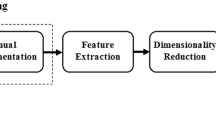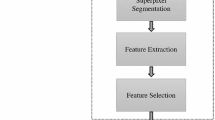Abstract
Osteosarcoma is a primary malignant bone tumor in children and adolescents with significant morbidity and poor prognosis. Diffusion weighted imaging (DWI) plays a crucial role in diagnosis and prognosis of this malignant disease by capturing cellular changes in tumor tissue early in the course of treatment without any contrast injection. Segmentation of tumor in DWI is challenging due to low signal-to-noise ratio, partial-volume effects, intensity inhomogeneities and irregular shape of osteosarcoma. The purpose of this study was to segment osteosarcoma solely utilizing DWI and identify effective and robust technique(s) for tumor segmentation. DWI dataset of fifty-five (N = 55; male:female = 41:14; Age = 17.8 ± 7.4 years) patients with osteosarcoma was acquired before treatment. Total nine automated and semi-automated segmentation algorithms based on (1) Otsu thresholding (OT), (2) Otsu threshold-based region growing (OT-RG), (3) Active contour (AC), (4) Simple linear iterative clustering Superpixels (SLIC-S), (5) Fuzzy c-means clustering (FCM), (6) Graph cut (GC), (7) Logistic regression (LR) (8) Linear support vector machines (L-SVM) and (9) Deep feed-forward neural network (DNN) were implemented. Segmentation accuracy was estimated by Dice coefficient (DC), Jaccard Index (JI), precision (P) and recall (R) using manually demarcated ground-truth tumor mask by a radiologist. Evaluated apparent diffusion coefficient (ADC) in segmented tumor mask and ground-truth tumor mask was compared using paired t test for statistical significance (p < 0.05) and Pearson correlation coefficient (PCC). Automated SLIC-S and FCM showed quantitatively and qualitatively superior segmentation with DC: ~ 79–82%; JI: ~ 67–71%; P: ~ 81–83%; R: ~ 80–86% and PCC = 0.89, 0.88 among all methods. Among semi-automated methods, AC was quantitatively more accurate (DC: ~ 77%; JI: ~ 65%; P: ~ 72%; R: ~ 88%; PCC = 0.85) than OT-RG and GC (DC: ~ 74–75%; JI: ~ 60–61%; P: ~ 67–72%; R: ~ 84–89%; PCC = 0.78, 0.73). Among machine learning algorithms, DNN showed the highest accuracy (DC: ~ 73%; JI: ~ 62%; P: ~ 77%; R: ~ 86%; PCC = 0.79) than LR and L-SVM (DC: ~ 70–71%; JI: ~ 58–63%; P: ~ 73%; R: ~ 74–85%; PCC = 0.69, 0.71). Execution times were instantaneous for SLIC-S, FCM and machine learning methods, while OT-RG, AC and GC took comparable ~ 1–6 s/slice image. Automated SLIC-S, FCM and semi-automated AC methods produced promising tumor segmentation results using DWI of the osteosarcoma dataset.


Similar content being viewed by others
References
Geller, D.S., Gorlick, R.: Osteosarcoma: a review of diagnosis, management, and treatment strategies. Clin. Adv. Hematol. Oncol. 8, 705–718 (2010)
Wong, K.-P.: Medical image segmentation: methods and applications in functional imaging. In: Suri, J.S., Wilson, D.L., Laxminarayan, S. (eds.) Handbook of biomedical image analysis: volume II segmentation models part B, pp. 111–182. Springer, Boston (2005)
Norouzi, A., Shafry, M., Rahim, M., et al.: Applications medical image segmentation methods, algorithms, and applications. IETE Tech. Rev. 3, 37–41 (2014). https://doi.org/10.1080/02564602.2014.906861
Ashton, E.A., Takahashi, C., Berg, M.J., et al.: Accuracy and reproducibility of manual and semiautomated quantification of MS lesions by MRI. J. Magn. Reson. Imaging 17, 300–308 (2003). https://doi.org/10.1002/jmri.10258
Costa, F.M., Ferreira, E.C., Vianna, E.M.: Diffusion-weighted magnetic resonance imaging for the evaluation of musculoskeletal tumors. Magn. Reson. Imaging Clin. NA 19, 159–180 (2011). https://doi.org/10.1016/j.mric.2010.10.007
Raghavan, M.: Conventional modalities and novel, emerging imaging techniques for musculoskeletal tumors. Cancer Control 24, 161–171 (2017)
Frangi, A.F., Egmont-petersen, M., Niessen, W.J., et al.: Bone tumor segmentation from MR perfusion images with neural networks using multi-scale pharmacokinetic features. Image Vis. Comput. 19, 679–690 (2001)
Mandava, R., Wei, B.C., Yeow, L.S.: Spatial multiple criteria fuzzy clustering for image segmentation. In: Second International Conference on Computational Intelligence, pp. 305–310 (2010)
Mandava, R., Alia, O.M., Wei, B.C., et al.: Osteosarcoma segmentation in MRI using dynamic harmony search based clustering. In: International Conference of Soft Computing and Pattern Recognition, pp. 423–429 (2010)
Huang, W., Wen, D., Yan, Y., et al.: Multi-target osteosarcoma MRI recognition with texture context features based on CRF. In: International Joint Conference on Neural Networks (IJCNN), pp. 3978–3983 (2016)
Ma, J., Li, M., Zhao, Y.: Segmentation of multimodality osteosarcoma MRI with vectorial fuzzy-connectedness theory. In: International Conference on Fuzzy Systems and Knowledge Discovery, pp. 1027–1030 (2005)
Zhao, Y., Hong, F., Li, M.: Multimodality MRI information fusion for osteosarcoma segmentation. In: IEEE EMBS Asian-Pacific Conference on Biomedical Engineering, pp. 166–167 (2003)
Chun-xiao, C., Dan, Z., Ning, L., et al.: Osteosarcoma segmentation in MRI based on zernike moment and SVM. Chinese J. Biomed. Eng. 22, 70–78 (2013)
Otsu, N.: A tlreshold selection method from gray-level histograms. IEEE Trans. Syst. MAN Cybern. SMC 9, 62–66 (1979)
Mancas, M., Gosselin, B., Macq, B.: Segmentation using a region growing thresholding. In: Proceedings of SPIE 5672, Image Processing: Algorithms and Systems IV, pp. 388–398 (2006)
Chan, T.F., Vese, L.A.: Active Contours Without Edges. IEEE Trans. Image Process. 10, 266–277 (2001)
Achanta, R., Shaji, A., Smith, K., et al.: SLIC Superpixels. IEEE Trans. Pattern Anal. Mach. Intell. 34, 2274–2282 (2012)
Selvathi, D., Arulmurgan, A., Alagappan, S.: MRI image segmentation using unsupervised clustering techniques. In: IEEE Proceedings of the 6th International Conference on Computational Intelligence and Multimedia Applications (ICCIMA’05), pp. 5–10 (2005)
Boykov, Y., Funka-lea, G.: Graph cuts and efficient N-D image segmentation. Int. J. Comput. Vis. 70, 109–131 (2006). https://doi.org/10.1007/s11263-006-7934-5
Cox, D.R.: The regression analysis of binary sequences. J. R. Stat. Soc. 20, 215–242 (2017)
Cortes, C., Vapnik, V.: Support-vector networks. Mach. Leaming 20, 273–297 (1995)
Du, X., Li, Y., Yao, D.: A support vector machine based algorithm for magnetic resonance image segmentation. In: 4th International Conference on Natural Computation A, pp. 49–53 (2008)
Havaei, M., Davy, A., Warde-farley, D., et al.: Brain tumor segmentation with deep neural networks. Med. Image Anal. 35, 18–31 (2017). https://doi.org/10.1016/j.media.2016.05.004
Sredhar, K., Panlal, B.: Enhancement of images using morphological transformations. Int. J. Comput. Sci. Inf. Technol. 4, 33–50 (2012)
Haralick, R.M.: Statistical and structural approaches to texture. Proc. IEEE 67, 786–804 (1979)
Galloway, M.M.: Texture analysis using grey-level run lengths. Comput. Graph Image Process 4, 172–179 (1975)
Mucciardi, A.N., Gose, E.E.: Comparison of seven techniques for choosing subsets of pattern recognition properties. IEEE Trans. Comput. C 20, 1023–1031 (1971)
Ferlay, J., Soerjomataram, I., Dikshit, R., et al.: Cancer incidence and mortality worldwide: sources, methods and major patterns in GLOBOCAN 2012. Int. J. Cancer 386, E359–E386 (2015). https://doi.org/10.1002/ijc.29210
Chen, C., Ding, S., Li, N., Wu, S.: Osteosarcoma segmentation in CT images based on hybrid relative fuzzy connectedness. In: 5th International Conference on BioMedical Engineering and Informatics, pp: 324–328. IEEE (2012)
Zhang, R., Huang, L., Xia, W., et al.: Computerized medical imaging and graphics multiple supervised residual network for osteosarcoma segmentation in CT images. Comput. Med. Imaging Graph 63, 1–8 (2018). https://doi.org/10.1016/j.compmedimag.2018.01.006
Liu, X., Haider, M.A., Yetik, I.S.: Unsupervised 3D prostate segmentation based on diffusion-weighted imaging MRI using active contour models with a shape prior. J. Electr. Comput. Eng. 2011, 1–2 (2011). https://doi.org/10.1155/2011/410912
Zhang, J., Baig, S., Wong, A., Haider, M.A.: Segmentation of prostate in diffusion MR images via clustering. Image Anal. Recognit. 10317, 471–478 (2017). https://doi.org/10.1007/978-3-319-59876-5
Saad, N.M., Muda, S., Mokji, M.: Segmentation of brain lesions in diffusion- weighted MRI using thresholding technique. In: 2011 IEEE International Conference on Signal and Image Processing Applications (ICSIPA), pp. 249–254. IEEE (2011)
Schakel, T., Peltenburg, B., Dankbaar, J., et al.: Evaluation of diffusion weighted imaging for tumor delineation in head- and- neck radiotherapy by comparison with automatically segmented 18F- fluorodeoxyglucose positron emission tomography. Phys. Imaging Radiat. Oncol. 5, 13–18 (2018). https://doi.org/10.1016/j.phro.2017.12.004
Acknowledgements
Authors would like to thank the Ministry of Human Resource Development, Government of India for providing the research fellowship funds to E.B.K. required for this study. Authors would also like to thank and acknowledge the valuable input of the intern team, Abhimanyu Sahai, Rishabh Gupta, Akshay Gupta, Kabir Chhbra and Sneha Patil in data processing and various stages of implementation of algorithms.
Author information
Authors and Affiliations
Corresponding author
Ethics declarations
Conflict of interest
The authors have no relevant conflicts of interest to disclose regarding this study.
Ethical approval
All procedures performed in studies involving human participants were in accordance with the ethical standards of the institutional and/or national research committee and with the 1964 Declaration of Helsinki and its later amendments or comparable ethical standards.
Informed consent
Informed consent was obtained from all individual participants included in the study.
Additional information
Publisher's Note
Springer Nature remains neutral with regard to jurisdictional claims in published maps and institutional affiliations.
Electronic supplementary material
Below is the link to the electronic supplementary material.
Rights and permissions
About this article
Cite this article
Baidya Kayal, E., Kandasamy, D., Sharma, R. et al. Segmentation of osteosarcoma tumor using diffusion weighted MRI: a comparative study using nine segmentation algorithms. SIViP 14, 727–735 (2020). https://doi.org/10.1007/s11760-019-01599-x
Received:
Revised:
Accepted:
Published:
Issue Date:
DOI: https://doi.org/10.1007/s11760-019-01599-x




